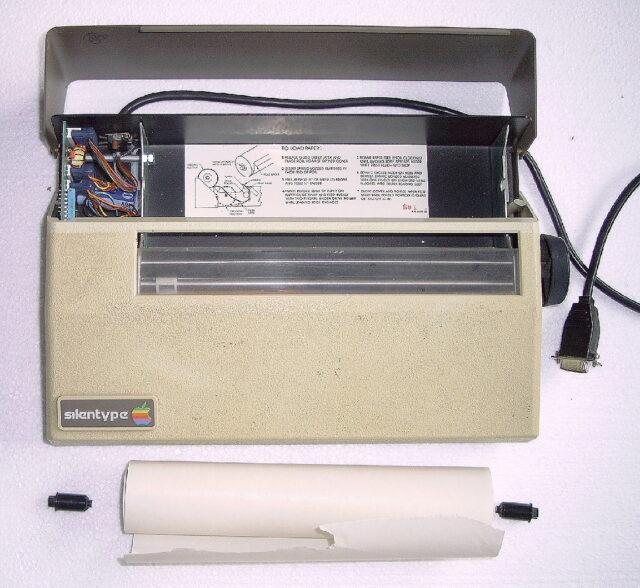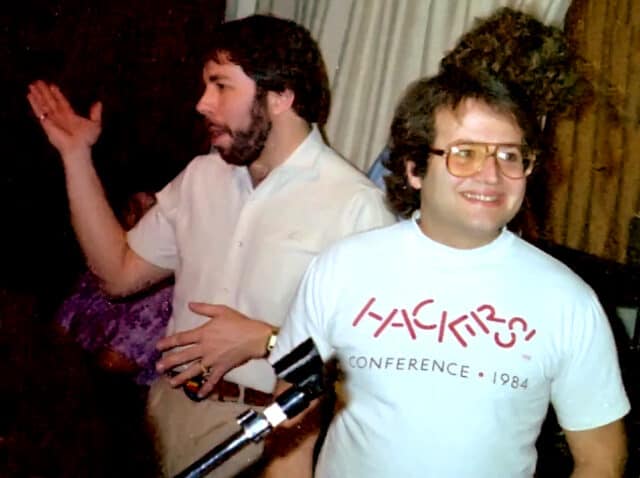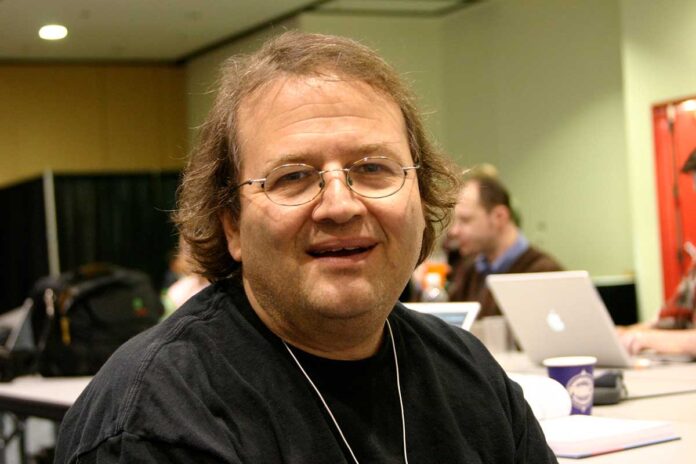Software developer Andy Hertzfeld is one of the most important heroes of Macintosh development, but he has rarely been in the spotlight. He was the technical lead for the Macintosh system software and was the second programmer to join the project, after Bud Tribble. Hertzfeld was responsible for the overall architecture of the system and wrote a substantial portion of the system code himself, while helping the other programmers to integrate their parts.
He was born on April 6, 1953, in Philadelphia, Pennsylvania, and grew up in the eastern United States.
He had his first exposure to computers in high school, although there was no computer at all in high school itself. “Back in the late ’60s and ’70s, high schools couldn’t afford computers, but there was a teleprinter-connected GE timesharing computer about 10 miles away. I was lucky enough to use a program in 11th grade. And I talked to it like a fish to water,” Andy told in an interview.
Back then, you couldn’t use the computer in real time; you had to write your program in advance, print it out on a punch tape, and then read it with a special reader to transmit the program to the computer. “It was a little cumbersome, but I loved it anyway.”
After high school, which he attended with Susan Kare, Andy Hertzfeld moved to California and studied at UC Berkeley. But after buying an Apple II, he found computing much more interesting than college. “I started spending all my time on it and dropped out of college to go to work for Apple in August of ’79.”
He was hired by Apple Computer as a systems programmer in 1979 and developed the Apple Silentype printer firmware and wrote the firmware for the Sup’R’Terminal, the first 80-column card for the Apple II. In the early 1980s, he invited his high school friend, artist Susan Kare, to join Apple in order to help design what would become standard Macintosh icons.

Foto: Von StromBer – CC BY-SA 3.0, https://commons.wikimedia.org/w/index.php?curid=14972849
The story of how Andy Hertzfeld was recruited for the Macintosh project is legendary: “Steve came by my cubicle. This was on a Thursday afternoon, late on a Thursday afternoon.,” Hertzfeld recalls in the Land of Giants podcast, talking with Peter Kafka. “I said ‘Okay, I’ll start Monday. Just give me half a day to document the work I’ve been doing so someone else can pick it up’. And he goes: ‘No, the Macintosh is the future of Apple. You’re going to start on it now.’ And he grabbed my Apple Two off my desk and started walking away with it. What could I do but follow my computer?”

Photo: Tony Wills – CC BY-SA 3.0, https://commons.wikimedia.org/w/index.php?curid=18512032
That’s how Andy Hertzfeld joined the Macintosh team. There he wrote much of the original system software for the Mac, including the User Interface Toolbox, Windows Manager, Menu Manager, Control Manager. Steve Jobs constantly gave the impression that there was a much bigger goal at stake: „We weren’t just designing a computer. We were saving mankind. We were enhancing the future of humanity. And so some of that you roll your eyes a little bit, but enthusiasm is contagious.“
With the legendary “1984” commercial, Jobs then also told the whole world that he was going to unveil something world-changing. But there was still one problem. At the time, he hadn’t completed this world-changing device. He needed Hertzfeld and a small team working around the clock, driven by the idea that they would create something great.
“It was a monumental effort to finish the Macintosh system software. All of the software engineers, about a dozen of us were up like 48 hours with no sleep”, Andy Hertzfeld recalls. “We barely succeeded. We were exhausted, lying around on the floor the next day in a happy haze. Hey, we did it. We’re finally done. When Steve walks into the software area saying, ‘Get up off the floor. You’re not done. I want the Macintosh to be the first computer to announce itself.”
Jobs verlangte also, dass Hertzfeld und sein erschöpftes Team dem Mac das Sprechen beibringen soll. Das war ein technischer Vorstoß, der das Team bis zur letzten Minute an die Grenzen der Belastungsfähigkeit getrieben hat. Und als Jobs dann auf der Apple-Aktionärsversammlung 1984 die Bühne betrat, zog er den Mac aus der Tasche, von dem Hertzfeld nicht wirklich überzeugt war, dass er funktionieren würde.
Jobs had gambled high and won. It worked. The Macintosh could talk, more or less at least. And it looked almost cuddly like it was smiling. And it was sealed so you couldn’t open it. Unlike other computers, which were designed so you could poke around and modify the guts of the machine, the Mac was designed for people who didn’t know or care about the difference between RAM and ROM or other computer terms. Turn it on and go, says Apple expert Peter Kafka.
Andy Hertzfeld: “The Mac had this great intro. People saw it as the revolution that it was. We started selling them to the colleges by tens of thousands. But by the fall of 1984, the sales started falling off. By Christmas 1984, the sales were very disappointing. They were maybe a 10th of what Apple had predicted.”
Andy Hertzfeld left Apple in April 1984, fairly soon after the Mac was introduced. When asked why he turned his back on Apple, Hertzfeld replied on “NerdTV”:
“Bob Cringley: Why did you choose to leave Apple?
Andy: I had a bad manager, a manager who wanted me to salute to him. I didn’t salute crisply enough.
Bob: Literally salute?
Andy: That’s metaphor. I call the story in my book “to big for my britches.” He took me for a walk to give me a verbal review. For the period of time I’d written most of the Macintosh system software he gave me a bad review because I was insubordinate to him. That disillusioned me. That took place in February 1983. I would have left then except I was too committed to the Mac. I had to stay to see it through. But as soon as it January 1984 left.
I was still able to do system software. Did Switcher, the first multitasking environment for the Macintosh just as an outsider – I was able to sell it back to Apple. I wasn’t going to work there because I loved the spirit of the Mac group but this guy came in – his name is Bob Belleville – the bad manager who made me quit, and wasn’t able to compromise enough to stay there.
Bob: Why didn’t Steve protect you?
Andy: Steve had promised to. When Bud Tribble, the former manager, had left, Burrell and I both almost quit. We were afraid we’d get a bad manager and Steve promised to protect me but at the time we had already essentially developed the Mac. The technical work was done and what Steve needed at that point were managers to take over the rest of Apple.
The Macintosh having shipped, his next agenda was to turn the rest of Apple into the Mac group. He had perceived the rest of Apple wasn’t as creative or motivated as the Mac team, and what you need to take over the company are managers, not innovators or technical people.
Bob: So at that moment he needed Bob Belleville more than he needed you?
Andy: That was what I thought. A little later on I think he thought he needed me more, but during that time, yeah. And of course it all kind of backfired on him. He (Steve) got kicked out of Apple just shortly afterwards… much o the ill fate of Apple. I almost killed Apple.”
Andy Hertzfeld left Apple in April of 1984, pretty soon after the introduction of the Mac. He helped his friend Burrell Smith who did the digital hardware for the Mac start a company called Radius in 1986 that made peripherals for the Mac. “I did a lot of stuff as a third-party developer, sold system software back to Apple. In 1990, along with Bill Atkinson, who was sort of my mentor on the Mac project, we started a company called General Magic that made some of the first handheld computers.”
Andy Hertzfeld: “Apple was our benefactor at starting General Magic, but about a year later decided they would rather BE General Magic and tried to make us blink out of existence… which we eventually did, but it took a few years. I left General Magic in 1996 to become an Internet hobbyist – got a T-1 line to my house. At one point I had all four food banks of the Bay Area hosted from this house here.”
But it was much too early for a real retirement. Andy got bitten by the free software bug in February of 1998 around the time of the Mozilla announcement. “I was despairing of the structural problems in the software industry and suddenly, after reading Eric Raymond’s book The Cathedral and the Bazaar, I realized that free software could be the path to an open and fair software industry.”
Hertzfeld decided to work for change in the traditional software industry. In August 1999, he founded a company called Eazel that would make free software easier to use. Eazel failed to secure its second round of funding, however, and he was forced to close the company in May 2001.
He then began working with Mitch Kapor. This is the man who developed the legendary spreadsheet program “Lotus 1-2-3.” Hertzfeld helped Kapor launch the Open Source Applications Foundation. Together they developed an innovative personal information manager called Chandler. He then launched a project to preserve for posterity the memories of the makers of the first Apple Macintosh.
To do this, Hertzfeld even developed his own software to publish these memories on the Web: the Folklore Project. “I established a website called folklore.org devoted to what I call “collective historical storytelling” — allowing a group of people to cooperate telling their shared stories. I published on the web about 60 anecdotes about the development of the Mac in time for the Mac’s 20th birthday in 2004.” This then became the book “Revolution in The Valley: The Insanely Great Story of How the Mac Was Made.”
Hertzfeld then spent the last years of his active professional career at Google.
From August 2005 to July 2013, Hertzfeld worked for Google, where he was primarily responsible for the Google+ user interface.
Hertzfeld is now mainly retired and describes himself as a retired hacker, but he still sometimes appears as an investor, most recently in the start-up Spatial.
Sources:
Interview Christoph Dernbach with Andy Hetzfeld on August 25, 2011 at WWDC 2011.
Interview Robert Cringely (NerdTV) with Andy Herzfeld
https://web.archive.org/web/20120728185354/https://www.pbs.org/cringely/nerdtv/transcripts/001.html
The Kamla Show: Silicon Valley Pioneers: Andy Hertzfeld
Podcast: „Land of Giants“ mit Peter Kafka, Episode 2: „This Changes Everything“
Wikipedia contributors. Andy Hertzfeld. Wikipedia, The Free Encyclopedia. November 4, 2022, 22:38 UTC. Available at: https://en.wikipedia.org/w/index.php?title=Andy_Hertzfeld&oldid=1120061717. Accessed December 22, 2022.


